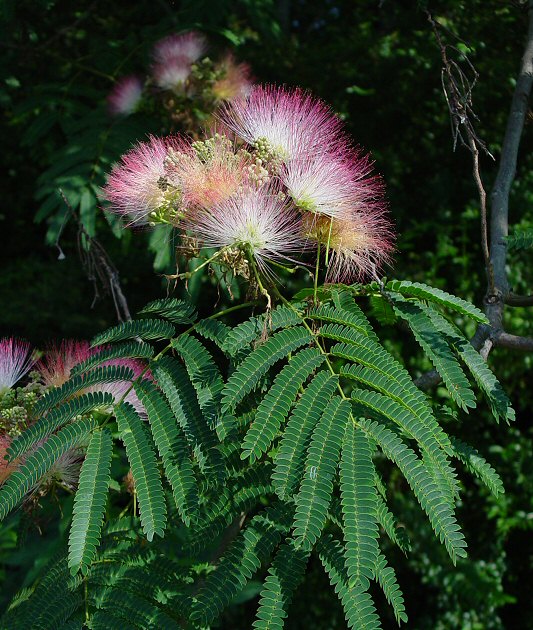Albizia julibrissin Durazz.
Mimosa

Introduced
CC = *
CW = 5
MOC = 19
© DETenaglia
Albizia julibrissin Durazz.Mimosa | |
 |
Introduced CC = * CW = 5 MOC = 19 |
© DETenaglia |
|
Family - Fabaceae/Mimosoideae Habit - Small tree, to 10 m. Stems - Woody, multiple or sometimes single. A tree or shrub to 6m tall. Twigs glabrous, somewhat angled, often growing in a slight "zig-zag" fashion.
Leaves - Alternate, even bipinnately compound, to 40 cm long. Leaflets opposite, to 1.5 cm long, 20-30 pairs per pinna, glabrous, asymmetric, the midvein near the upper margin. Leaflets close together along the rachis at night.
Inflorescence - Axillary, pedunculate clusters of +/-20 flowers. Clusters subglobose. Flowers sessile.
Flowers - Corolla tubular, 5-lobed, creamy white to greenish, pubescent. Lobes to 2 mm long, acute. Stamens many per flower, pinkish at tips, whitish at the base, to 2.5 cm long, united at base into tube 3 mm long, glabrous. Style 1, pink, 2 cm long, filiform, glabrous. Ovary terete, green, 3 mm long, 0.5 mm broad. Calyx tube 3 mm long, 5-lobed, appressed pubescent, pale green. Lobes minute. Flowers fragrant.
Fruits - Legumes to 20 cm long, 10-20 mm wide, narrowly oblong, tapered to a short, stalklike base, strongly flattened, straight, the margins sometimes slightly undulate and occasionally more strongly narrowed between a few of the seeds, the surfaces slightly constricted between the seeds, finely hairy when young, usually glabrous or nearly so at maturity, light tan at maturity, indehiscent tardily dehiscent. Seeds 12-18, 7-8 mm long, 4 mm wide, oblong-ovate, flattened, light brown.
Flowering - June - September. Habitat - Cultivated but escaped to dry areas along roadsides, railroads, open woods, thickets, and fence rows. Origin - Native to Asia. Other info. - This species is widely cultivated in Missouri for its gracefully spreading leaves and numerous attractive flower clusters. The flowers are very fragrant, especially at night, and are visited by hummingbird moths, Hemaris thysbe, on a regular basis. The plant propagates readily from seed or cuttings and grows rapidly. Unfortunately these attributes have become problematic in areas in the southeast of the state, where the plant becomes invasive in some habitats. Photographs taken in Poplar Bluff, MO., 6-11-04 and near Birmingham, AL., 6-20-04 (DETenaglia); also near Pacific, MO, 7-27-2015, and near Labadie, Franklin County, MO, 7-27-2022 (SRTurner). |